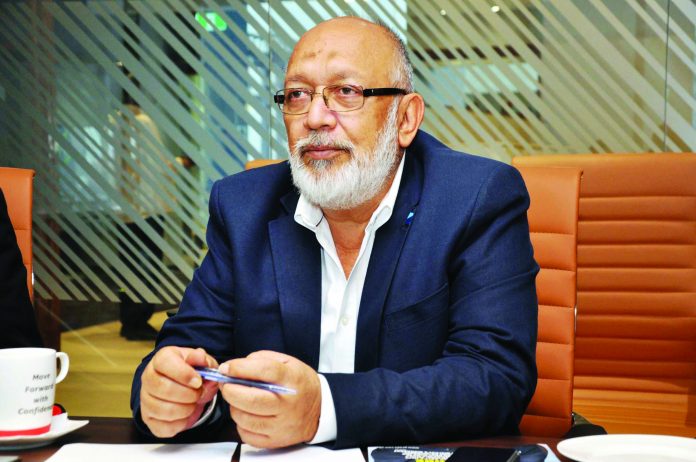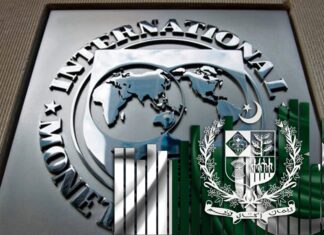If you take an aerial view of South Asian Port Terminal (SAPT), an under construction member port of Hutchison Ports Holding (HPH) being built in collaboration with the Karachi Port Trust (KPT), you instantly spot the best location for anchoring huge mother vessels in Pakistan. HPH is the world’s leading port investor, developer and operator, operating 319 berths at 52 ports in 26 countries. The management in Hong Kong is directly overlooking all aspects of the port, bringing in huge expertise and experience of port management from across the globe.
SAPT serves as the most convenient port for trade resolve with the Central Asian and South Asian countries.It is being built with an investment of over $600 million on HPH’s part while the local government has spent approximately $800 million on its infrastructure that includes waves-breakers, dredging in deep water, roads and bridges etc.
SAPT will open new horizons for trade in Pakistan. Presently a large percentage of Pakistan’s export and import cargo in containers is not routed through Karachi directly to final destinations, as large and very large mother ships cannot berth at existing container terminals. So these cargoes are taken to deep sea ports like Jebel Ali on smaller container vessels, and then unloaded and reloaded onto the mother ships there. All this means extra costs, time delays, higher risk, more documentations and overall inefficiencies.
Often at short notice, exporters lose orders owing to the non-availability of space on smaller vessels when needed. This deficiency will be overcome with the mother ships of huge capacity calling at SAPT. The port will directly accommodate the mother ships, leading to greater exports and quicker receipt of import cargoes.
In a nutshell, the main aim of SAPT, spread over 85 hectares of land, is to become Pakistan’s premier container terminal operator. Located within the Karachi Port, it is a natural deepwater harbor west of the Indus Delta on the Arabian Sea. It is going to play a pivotal role by complementing the rapid growth in Pakistan’s economy through trade.
As a result of this terminal, Pakistan will be able to accommodate deep container ships which were not possible prior to the operation of this port. There will be significant economic benefits such as reduced costs to the country’s importers and exporters, improved transit time for shipments leading to efficiencies in supply chains, creation of direct and indirect job opportunities, and taxation benefits to the government and other stakeholders.
SAPT has a lot of significance when it comes to meeting the growing shipping needs of Pakistan. This can be an early harvest project from China Pakistan Economic Corridor (CPEC)’s point of view because Gwadar Port, which lacks supporting infrastructure – power, storage, roads, railways etc – will take a while to fully develop.

The taxation benefits to the local economy have already started to accrue and are envisioned to grow as the traffic for the terminal grows swiftly in the next couple of years, sources say.
In an interview with the Profit magazine Capt. Syed Rashid Jamil, CEO SAPT Hutchison Port says, “inauguration of this port will open new gateways for the international businesses from Pakistan through huge mother ships having containers’ capacity of 18,000-20,000 TEUs. Logistic cost on good transportation would be reduced with quick services and infrastructures.”
The SAPT would further help to minimise cost of doing business in Pakistan similar to other neighbouring countries.He said,“ we have equipped it with state-of-the-art technology, which includes automated gates with identity cards checking system, RTGCs with position determination systems, remote controlled cranes (operated with CROS), control tower coordination, CCTV and trunk radio systems, mobile terminal messaging system, etc.” Furthermore, in order to facilitate operations, leading technology has been installed for navigation, berthing, loading / unloading, yard and storage, customs inspection and all other functions.
“It would be operational by mid March this year as 16-meter dredging in open sea is almost going to be completed in next few days”, said Rashid. He further added,“KPT has chosen the right contractor Van Oord, a Belgian Company, for dredging in deep water and it has done a very satisfactory job so far.”
“We expect that by the mid or end of this month, we will have enough depth to open our channels for the access for large vessels,” he claimed. He seemed satisfied with the ongoing work and the speed at which it (work) is being done. He further explained that as per the agreement, the required depth of the sea is around 16 meters, which can be extended to 18 or 20 meters if need be.
Interestingly enough, SAPT’s expected annual capacity of 3.1 million TEUs is more than the combined existing capacity of three ports namely Karachi International Container Terminal, Qasim International Container Terminal and Pakistan International Container Terminal. They have a total annual capacity of 2.5 million TEUs.

The Pakistani government is targeting another milestone achievement in collaboration with China through the development of Gwadar as a deepwater port (Free Port). It is expected to become fully operational by 2025-30 inline with the completion of China Pakistan Economic Corridor (CPEC) initiative and its related economic zones etc in Gwadar city and neighboring areas.
The SAPT port, as per the agreement with government of Pakistan, had to be completed in 2011 but was delayed owing to a lack of interest from concerned authorities, dredging issues and road infrastructure etc among the many.
“The project has been delayed for almost 6 years now” Mr Rashid says. “Has there ever been a feeling of discomfort in this regard from HPH, considering the huge amount of investment and still no return on it?,” he questions. “Pakistan’s basic need was the deepwater port to reduce the cost of import or export which HPH accomplished, he claims.
HPH came to Pakistan with the vision of developing the shipping and trade industry and the commitment of the company can be gauged by the fact that despite delays, HPH remains fully committed to meeting deadlines for the existing project and to Pakistan.

Back in 2011, he says, “the company had an option of pulling out of the project as per the agreement, but despite all the delays and challenges, it did not exercise that option because the company fully believed that the project would succeed. Its regional management in Hong Kong, in particular, had the confidence and belief that this project will be completed. They still maintain that they are committed to the vision of developing Pakistan as a successful deepwater terminal operating region.
“I am very optimistic about Pakistan’s economy,” said Mr Rashid. Pakistan is a very resilient country despite problems in the past and he is sure there will be challenges in the future as well. He believes that the nation’s resilience and innovation are its biggest strengths. He seemed very hopeful thinking that if we can capitalize on our strengths, no one can stop Pakistan from reaching the sky limit.
Mr Rashid also informed the profit team that KPT has sought time from Prime Minister for the inauguration of the SAPT port due to be inaugurated in March 2017. Van Oord is rapidly finalizing its dredging work and it is being hoped that the task will be completed by 2nd week of the current month.

“On December 19, 2016, the company has initiated its test operations at ‘One A port’, while One B, One C and One D ports are still under construction.Another port of ours ‘One B’ would be operational by April this year,” said the company official. Adding to it, he said, “so far we had handled more than 35000 TEUs from 19 vessels and we cleared big ships in very short time. Our test operations are free of cost and we are not charging for it. During test operations, we also set a national record with a ship called MSC Lucy, accomplishing almost 1700 container moves in just under 17 hours with a Vessel Operating Rate (VOR) of 129.”
This is what makes SAPT so different from other terminals – its speed and efficiency is greater because of the latest state-of-the-art equipment that are in place.It is being operated by a very highly skilled workforce. SAPT’s biggest advantage is that it will be able to call large size ships that are being handled by large sized cranes. This means that the speed of clearing ships and moving containers would be much higher than the rest of the terminals.
“SAPT is the only private container terminal that has been designed and built as a specialized container terminal. Three other container terminals presently existing have been created on berth and yard areas, originally meant for bulk cargo,” Mr. Rashid said.
In addition to this, the CEO said that the terminal will be one of the first ever to introduce an online payment system for customers, thus eliminating most of the tedious paperwork one needs to currently go through, to have a shipment processed and cleared.
He said the company had so far handled 82.9 million TEU until 2014, playing a significant role in the development of economies and the expansion of international trade of the countries. The CEO added, “our constant pursuit to ensure the level of standard and quality across all countries keeps growing consistently.”

The logistics industry will be a major beneficiary of the project and the primary reason is the massive cost reductions it will bring because of speed and Just-In-Time. For example, for transporters the cost of moving trucks per mile will significantly go down because of the quick turnaround our company will provide. This will benefit both the end users as well as the shipping lines. In the long run, even the consumers will benefit as there will always be the possibility of reduced prices for the products they purchase.
Responding to a question regarding challenges, Mr Rashid said that challenges are a part of the business. “As a company, we are using our expertise, workforce and facilities to overcome those challenges and we have been successful in doing that so far.”
Mr Rashid further said that challenges at ports are usually not just about manpower or equipment, in fact, they are mostly about regulatory matters. For example, lack of proper roads, infrastructure, delays in Customs clearance, changes in government policies etc. “If you assess this, the challenges that we are facing are not very different from what other industries and sectors face. This is all part and parcel of the business,” he commented.

“Our biggest challenge remains infrastructure” he said adding, “Our business is to transport containers and for that we need good road access and this facility we are lacking right now in Pakistan. Currently all trucks from the Karachi Port pass through the Native Jetty Bridge, which is also used for other transportation by the general public. This causes a lot of traffic disturbances on the bridge. Ideally, there is a need to develop bypass over the bridge for heavy transport in order to run smoothly. This bridge will significantly help our overall operations, which has been committed by the government and KPT.”
Regarding the CPEC, he said that Gwadar and SAPT are both deep water ports even though there is no direct relation between them. “There will be an impact towards the development of CPEC as the trade in the country will be facilitated through bigger ships and frequency of trade will increase leading to an overall boost to the company.”
Traders will have more choices and will not be restricted to just one port and this will attract more trade and competition. Also, Gwadar is going to take time to become fully functional because the city has to develop first, the industry and the skill have to develop as well. So at least till then, Pakistani businessmen can take advantage of the services being offered by SAPT due to its convenient location.

He further commented that the competition is fierce which is always a good sign not only for the customers but also for the overall trade and economy of Pakistan. “With Gwadar in particular, competition will be there since both are deep sea ports operating within 200-300 nautical miles of each other. Both have their strengths and weaknesses.
Other than trade, HPH’s major focus is to develop environment as this is an area the company has been looking to invest in. The company aims to become a major contributor towards the betterment of the environment and society. “What we are doing is implementing the best environmental practices from around the world. Practices that international environmental regulation does not allow, we are also making a conscious effort to follow the same route here in Pakistan,” he added.
Another of HPH’s major areas of focus is human resource and the company is believed to be already contributing to direct and indirect employment in Pakistan. As other phases of the project will unfold, the company expects to open up more jobs for the people of the country. “Our parent company HPH makes a conscious effort in sourcing, developing and training local talent and giving them the skill set that will help them become integral contributors not just to the company but also the overall economy of Pakistan. And this is why majority of our staff is Pakistani. We do have Chinese staff too so our local teams are able to learn from their expertise, improving their overall skill. We believe there is talent in Pakistani people and as a company, we are fully committed to training and developing them with the required skill sets needed to succeed not only professionally but personally as well. Our idea is to develop future role models.”

Capt. Rashid Jamil started his professional career in 1986 as Port Captain of Pakistan National Shipping Corporation (PNSC). He then worked as Pakistan Sales Manager at Sea Land Pakistan Agencies in 1994. He holds a degree in Nautical Pre-Sea from the Marine Academy of Pakistan.Mr Rashid joined KPT in 1997. He has been a member of HPH group since April 2015. After gaining vast experience handling Karachi International Container Terminal (KICT)’s operations while- for 9 years, he became the Chief Operating Officer of the terminal. He was then transferred to Oman as deputy CEO and COO of Oman International Container Terminal (OICT) in 2013. Finally he became part of the SAPT project as the Project Director in 2015 and was later promoted as its CEO.
























